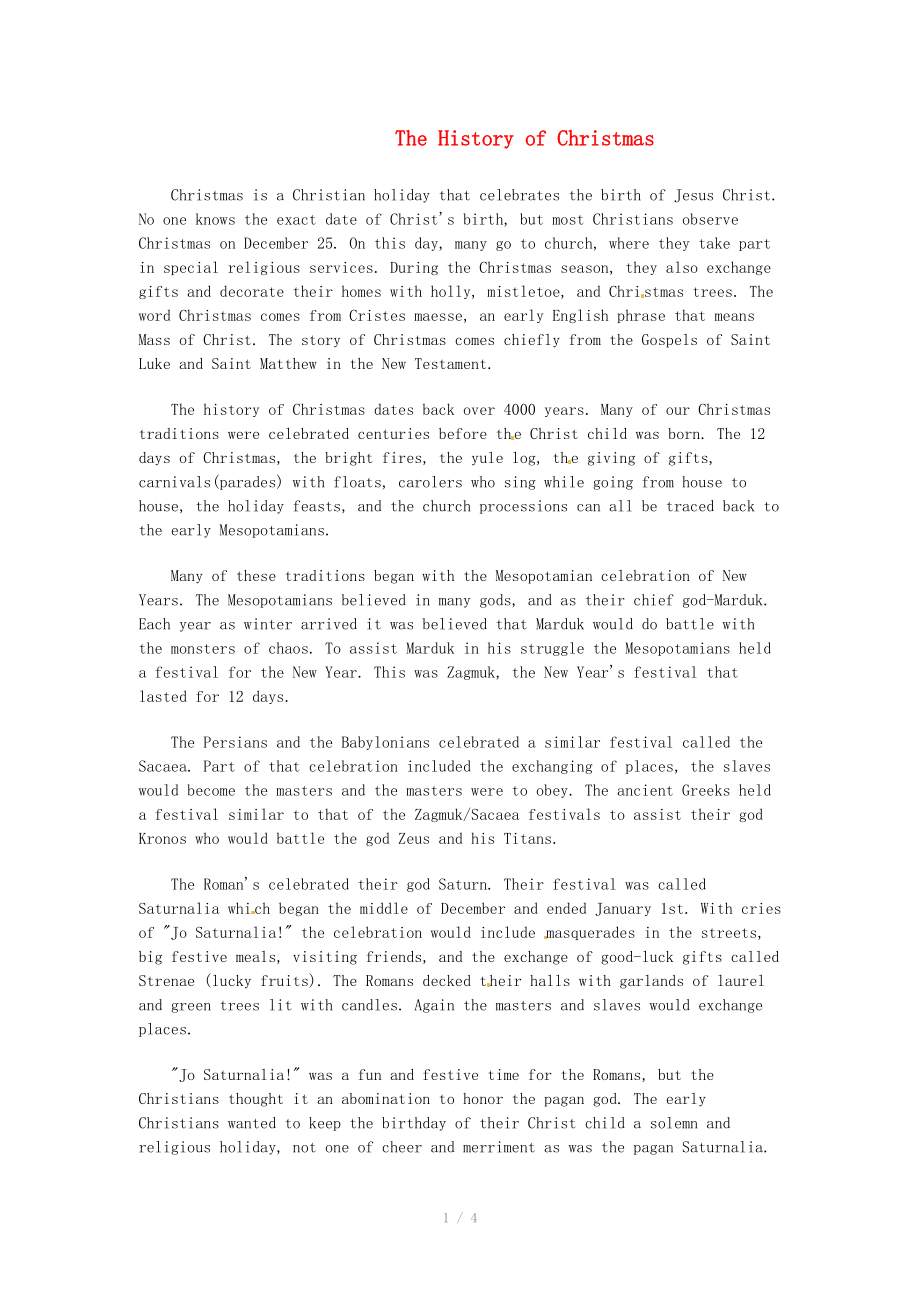《2014年秋高中英語 Module 4 Carnival The History of Christmas訓(xùn)練 外研版必修》由會員分享�,可在線閱讀,更多相關(guān)《2014年秋高中英語 Module 4 Carnival The History of Christmas訓(xùn)練 外研版必修(4頁珍藏版)》請在裝配圖網(wǎng)上搜索�。
1、
The History of Christmas
Christmas is a Christian holiday that celebrates the birth of Jesus Christ. No one knows the exact date of Christs birth, but most Christians observe Christmas on December 25. On this day, many go to church, where they take part in special religious services. During the
2�、 Christmas season, they also exchange gifts and decorate their homes with holly, mistletoe, and Christmas trees. The word Christmas comes from Cristes maesse, an early English phrase that means Mass of Christ. The story of Christmas comes chiefly from the Gospels of Saint Luke and Saint Matthew in t
3、he New Testament.
The history of Christmas dates back over 4000 years. Many of our Christmas traditions were celebrated centuries before the Christ child was born. The 12 days of Christmas, the bright fires, the yule log, the giving of gifts, carnivals(parades) with floats, carolers who sing whil
4�、e going from house to house, the holiday feasts, and the church processions can all be traced back to the early Mesopotamians.
Many of these traditions began with the Mesopotamian celebration of New Years. The Mesopotamians believed in many gods, and as their chief god-Marduk. Each year as winter
5、 arrived it was believed that Marduk would do battle with the monsters of chaos. To assist Marduk in his struggle the Mesopotamians held a festival for the New Year. This was Zagmuk, the New Years festival that lasted for 12 days.
The Persians and the Babylonians celebrated a similar festival cal
6�、led the Sacaea. Part of that celebration included the exchanging of places, the slaves would become the masters and the masters were to obey. The ancient Greeks held a festival similar to that of the Zagmuk/Sacaea festivals to assist their god Kronos who would battle the god Zeus and his Titans.
7、The Romans celebrated their god Saturn. Their festival was called Saturnalia which began the middle of December and ended January 1st. With cries of "Jo Saturnalia!" the celebration would include masquerades in the streets, big festive meals, visiting friends, and the exchange of good-luck gifts cal
8�、led Strenae (lucky fruits). The Romans decked their halls with garlands of laurel and green trees lit with candles. Again the masters and slaves would exchange places.
"Jo Saturnalia!" was a fun and festive time for the Romans, but the Christians thought it an abomination to honor the pagan god.
9、The early Christians wanted to keep the birthday of their Christ child a solemn and religious holiday, not one of cheer and merriment as was the pagan Saturnalia.
Some legends claim that the Christian "Christmas" celebration was invented to compete against the pagan celebrations of December. The
10�、25th was not only sacred to the Romans but also the Persians whose religion Mithraism was one of Christianitys main rivals at that time. The Church eventually was successful in taking the merriment, lights, and gifts from the Saturanilia festival and bringing them to the celebration of Christmas.
11、2 / 4
The exact day of the Christ childs birth has never been pinpointed. Traditions say that it has been celebrated since the year 98 AD. In 137 AD the Bishop of Rome ordered the birthday of the Christ Child celebrated as a solemn feast. In 350 AD another Bishop of Rome, Julius I, choose Decemb
12�、er 25th as the observance of Christmas.
The birth of Jesus had a story: In Nazareth, a city of Galilee. The virgins name was Mary was betrothed to Joseph. Before they came together, she was found with child of the Holy Spirit. Joseph her husband was minded to put her away secretly. While he thoug
13、ht about these things, Gabriel, an angel of the Lord appeared to him in a dream and told him did not be afraid to take Mary as wife. And Mary will bring forth a Son, and he shall call his name, Jesus, for he will save his people from their sins.
Before Jesus births, Joseph and Mary came to Quirni
14�、us was governing Syria. So all went to be registered, everyone to his own city. Joseph also went up out of Galilee, out of the city of Nazareth, into Judea, to the city of David, which is called Bethlehem, because he was of the house and of the lineage of David, to be registered with Mary, his betro
15、thed wife, who was with child. So it was that while they were there, the days were completed for her to be delivered. And she brought forth her firstborn Son, and wrapped him in swaddling cloths, and laid him in a manger, because there was no room for them in the inn.
And that, Christmas is the f
16�、east of the nativity of Jesus, is on 25th, December every year. But nobody knows the actual birthday of Jesus. And the Christmas has become popular when Christmas cards appeared in 1846 and the concept of a jolly Santa Claus was first made popular in nineteenth Century.
The custom of giving gifts
17、 to relatives and friends on a special day in winter probably began in ancient Rome and northern Europe. In these regions, people gave each other small presents as part of their year-end celebrations.
In the 1800s, two more Christmas customs became popular--decorating Christmas trees and sending
18�、Christmas cards to relatives and friends. Many well-known Christmas carols, including ``Silent Night" and ``Hark! The Herald Angels Sing," were composed during this period. In the United States and other countries, Santa Claus replaced Saint Nicholas as the symbol of gift giving.
The word Xmas is sometimes used instead of Christmas. This tradition began in the early Christian church. In Greek, X is the first letter of Christs name. It was frequently used as a holy symbol.
希望對大家有所幫助,多謝您的瀏覽�!
 2014年秋高中英語 Module 4 Carnival The History of Christmas訓(xùn)練 外研版必修
2014年秋高中英語 Module 4 Carnival The History of Christmas訓(xùn)練 外研版必修

